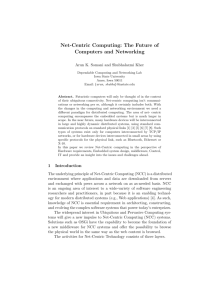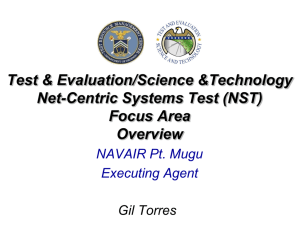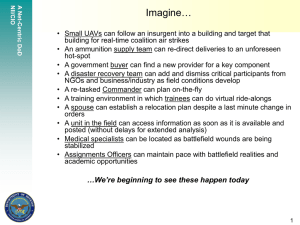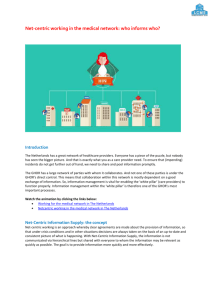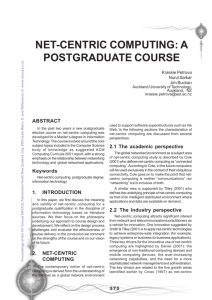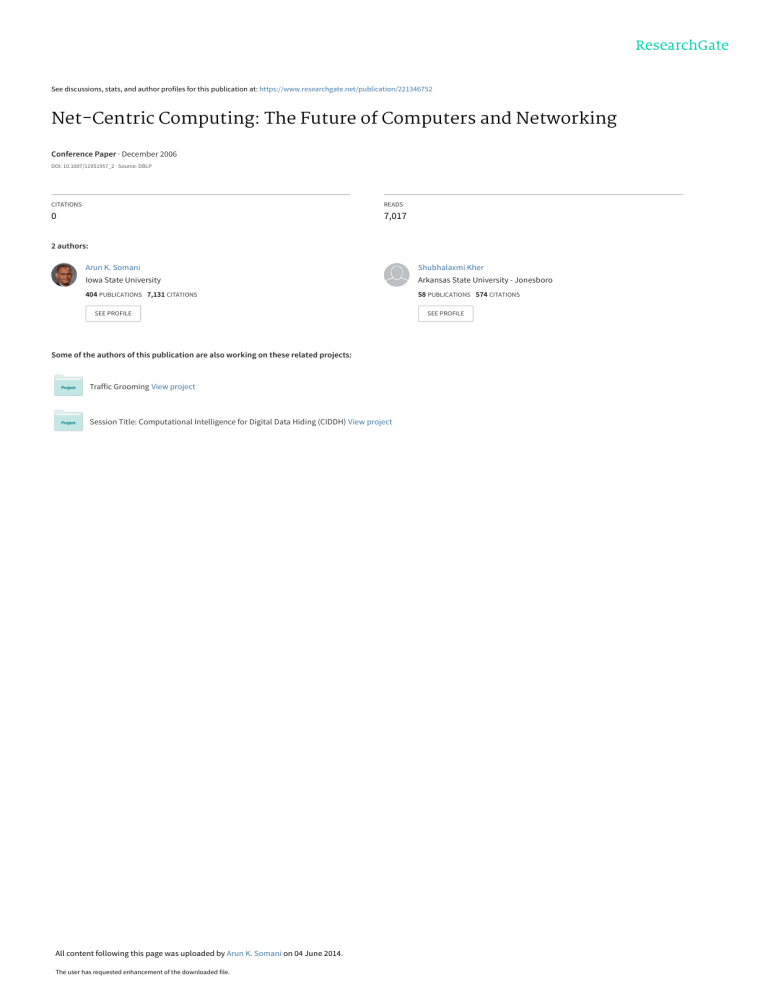
See discussions, stats, and author profiles for this publication at: https://www.researchgate.net/publication/221346752
Net-Centric Computing: The Future of Computers and Networking
Conference Paper · December 2006
DOI: 10.1007/11951957_2 · Source: DBLP
CITATIONS
READS
0
7,017
2 authors:
Arun K. Somani
Shubhalaxmi Kher
Iowa State University
Arkansas State University - Jonesboro
404 PUBLICATIONS 7,131 CITATIONS
58 PUBLICATIONS 574 CITATIONS
SEE PROFILE
Some of the authors of this publication are also working on these related projects:
Traffic Grooming View project
Session Title: Computational Intelligence for Digital Data Hiding (CIDDH) View project
All content following this page was uploaded by Arun K. Somani on 04 June 2014.
The user has requested enhancement of the downloaded file.
SEE PROFILE
Net-Centric Computing: The Future of
Computers and Networking
Arun K. Somani and Shubhalaxmi Kher
Dependable Computing and Networking Lab
Iowa State University
Ames, Iowa 50011
Email: {arun, shubha}@iastate.edu
Abstract. Futuristic computers will only be thought of in the context
of their ubiquitous connectivity. Net-centric computing isn’t communications or networking per se, although it certainly includes both. With
the changes in the computing and networking environment we need a
different paradigm for distributed computing. The area of net- centric
computing encompasses the embedded systems but is much larger in
scope. In the near future, many hardware devices will be interconnected
in large and highly dynamic distributed systems, using standard communication protocols on standard physical links [1] [3] [5] [6] [7] [8]. Such
types of systems exist only for computers interconnected by TCP/IP
networks, or for hardware devices interconnected in small areas by using
specific protocols for the physical link, such as Bluetooth, Ethernet or
X-10.
In this paper we review Net-Centric computing in the perspective of
Hardware requirements, Embedded system design, middleware, Control,
IT and provide an insight into the issues and challenges ahead.
1
Introduction
The underlying principle of Net-Centric Computing (NCC) is a distributed
environment where applications and data are downloaded from servers
and exchanged with peers across a network on as as-needed basis. NCC
is an ongoing area of interest to a wide-variety of software engineering
researchers and practitioners, in part because it is an enabling technology for modern distributed systems (e.g., Web applications) [4]. As such,
knowledge of NCC is essential requirement in architecting, constructing,
and evolving the complex software systems that power today’s enterprizes.
The widespread interest in Ubiquitous and Pervasive Computing systems will give a new impulse to Net-Centric Computing (NCC) systems.
Solutions such as OSGi have the capability to become the foundation of
a new middleware for NCC systems and offer the possibility to browse
the physical world in the same way as the web content is browsed.
The activities for Net-Centric Technology consists of three layers.
– The Information Service Layer pertains to the abstraction of objects.
The focus here is on the quality, security, auditability and control.
– The Network Service Layer pertains to all aspects of communications,
particularly configuration, fault management, security, performance
and accounting.
– The Component Control Layer pertains to the development, acquisition and implementation of components that form the infrastructure
for distributed computing.
Fig. 1. Net-centric Computing and Data Fusion
Figure 1 shows the environment for Net-centric computing. For several years, business and technology observers have been talking about
the major changes being brought by universal networking capabilities,
such as the Internet. Today’s technology solutions are what we can call
”convergence” solutions: They represent the convergence of computing
power, communications capability and content the information, data or
knowledge that forms the ”stuff” of the solution. At the heart of the
solution, however, is the networkhence, network-centric, or ”netcentric,”
solutions. Net-centric computing refers to an emerging technology architecture and an evolutionary stage of client/server computing. The common architecture of netcentric computing supports access to information
through multiple electronic channels (personal and network computers,
cell phones, kiosks, telephones, etc.). This information is made accessible
to many more users not just an organization’s workforce but also its customers, suppliers and business partners through technologies that employ
open, commonly accepted standards (Internet, Java, Web browsers and
so forth).
Fig. 2. Net-centric computing vs Distributed systems
Figure 2 shows how Distributed computing is different than NetCentric computing. Netcentric computing is a common architecture built
on open standards that supports many different ways for many different
kinds of people to collaborate and to reach many different information
sources [2]. The evolutionary yet radical nature of netcentric solutions
can be seen in many of those already implemented. The robust architecture of netcentric computing has the ability to evolve as new channels and
functionality become available. Netcentric computing links technological
capability and strategic opportunity, helping to open today’s new markets
and provide the flexibility to meet tomorrow’s business challenges. It can
also add complexity and risk to information systems. Net-centric computing is like a box. Open the box; Inside, there is technology that seems both
familiar and new. Something that will do great things for a business. It
can enable true e-commerce capabilities. For any business/organization,
it can link customers, suppliers, employees and other business partners to
its information systems, and thus to its entire business anywhere in the
world. It can maximize the flow of information inside any organization,
allowing people to share data and knowledge, to collaborate more effectively. This will, in fact, redefine the industry and create new markets.
It is easy to recognize pieces of it: your client/server system, your
legacy applications, your network. Yet, taken as a whole, it represents a
new kind of technology infrastructure for your organization that links,
perhaps for the first time, technology capability with new business opportunity. When you read or hear today of companies opening up new
markets, engaging in e-Commerce, delighting their customers with unprecedented levels of services or streamlining their internal processes by
encouraging the sharing of information and data, that’s netcentric computing in action.
1.1
Flow Computing Model
In this context of net-centric computing we propose a new distributed
computing paradigm [8] called flow computing in which nodes comprising the internet can be dynamically contracted to perform the required
computing tasks. With the increasing computing capabilities of the router
nodes or by specifically deploying additional computing facilities, some of
the end hosts (client or server) computation may be delegated to the
intermediate nodes (INs). The instructions about how to do the processing may be provided by the end hosts. Thus internet is converted into
a large distributed computing environment, we call this paradigm flow
Computing because data are processed on the fly enroute from source
to destination. Only a few nodes may be equipped to support such Flow
computing. Figure 3 shows a flow computing model.
Individual nodes may be designed to provide specific or general computing services. To facilitate such a facility, we propose to develop a reliable transport layer protocol, called Intermediate Processing Protocol
(IPP) for processing within the internet. The protocol design makes provisions for connection set up handshake, processing capability reservation,
intermediate processing, data acknowledgement, buffering and retransmission, flow and congestion control, ordered delivery and security issues.
Flow computing is different than Peer to Peer computing and grid
computing environment models where the computing nodes are known in
advance with the help of certain services. In our model, the end nodes
need not be aware of location of such services and no centralized or distributed directory services are maintained. Figure 4 shows components of
Fig. 3. Flow computing model
a flow computing model. The broader impact of flow computing approach
is to allow a large number of different kinds of hosts to be integrated into
the internet computing environment and provide ubiquitous services to
a large class of small devices and reduce need for large and or centralized servers. Some of the major advantages of flow computing are: full
CPU/memory utilization; new business model for ISPs; simplified client
and server implementation; support for new multimedia applications for
wireless clients; and new distributed computing paradigm by way of merging/processing data as it flows from various sources to clients.
In a flow computing model, application flows are meaningfully processed to satisfy end host requirements, and efficiently utilized for computing and network resources. Due to the support for intermediate processing this model would be a generalization of other distributed object
models like grid computing, peer to peer computing and client server computing. Our flow computing model has the advantages of both P2P and
grid computing as it enables data sharing and processing by treating the
entire network as a reliable computing engine, including the intermediate
routers or enhanced routers with little additional overhead.
Flow computing proposes to use a new transport layer protocol that
seamlessly integrates with the widely used TCP/IP protocol suite. The
idea in this work stems from the observation that there is an increasing
number of devices with varying computing powers and energy sources
being connected to the internet. End hosts may or may not be able to
Fig. 4. Components of Flow model
perform all the computations whose results are of interest to them due to
unavailability of computation power or need for energy conservation. The
data source may not be able to provide such computing services, but may
get overloaded due to a large number of such clients. Moreover in certain
environment all raw data may be stored on large data repositories such as
disk farms that may be optimized towards streaming data from disks to
networks to be processed by servers located elsewhere. Related is a scenario where data needed for processing may be distributed such as sensor
networks. In such cases it would be more prudent to assign computing
task to some intermediate node rather than to a single source/server.
One such environment is Enterprize computing, with a secured networking environment. Consider a scenario an executive of a company
would like to view total sales data for a specific product line on his cell
phone. The computation needs to obtain raw sales data from the data
server and after processing display the result. If the data server does not
have the needed processing power and cell phone would not like to manage this data, who should provide the service? Our goal is that either the
cell phone host on the forward path or the data server on the backward
path during establishment of connection should have contracted this ser-
vice out to some intermediate node who is a willing participant and has
idle capacity available at the time the request is being processed.
2
2.1
Aspects of Net-centric Computing
Architectures
ComP2P CompuP2P given in [7] is an architecture for sharing of computing resources in Internet-scale computational grids. It provides idle
resources, such as processing power, memory storage etc., of computing
engines that have Internet connectivity and are under-utilized most of the
time to user applications that might require them. It achieves this objective by allowing owners of idle resources to sell to those who need them.
Thus applications, like scientific simulations and data mining, requiring
large processing requirements, can tremendously benefit from potentially
unlimited availability of compute power provided by CompuP2P. Likewise, database applications, requiring huge storage, can harness the disk
capacity of virtually millions of machines connected to the Internet.
Fig. 5. ComP2P architecture
CompuP2P shown in Figure5 uses light-weight protocols for building
and operating dynamic computing resource markets, where sellers and
buyers can come together to negotiate transfer (usage) of resources from
seller to buyer nodes. To meet the resource sharing requirements, the
lookup of such markets and the availability of resources are robust even
in the face of several nodes entering or leaving the network at the same
time. CompuP2P uses ideas from game theory and microeconomics to
devise incentive-based schemes for motivating users to share their idle
computing resources with each other. The trading and pricing of resources
is done in a completely distributed manner without requiring any trusted
centralized authority to oversee the transactions.
Pricing Structure and Incentive Based Allocation Pricing in CompuP2P markets, where buyers (clients) pay to sellers (computing nodes)
and intermediaries (MOs) that facilitate the transactions, can be a nontrivial issue. Unlike in real-world, there likely will be no well established
protocols (government rules and policies), and institutions and infrastructure (such as stock exchanges) in an Internet-scale computational
grid setting that can govern the parameters (such as the price charged,
the place of occurrence etc.) of the transactions. Due to such constraints
several non-trivial issues need to be addressed - setting resource prices,
determining payoffs to intermediate, preventing cheating etc. We again
borrow ideas from game theory and microeconomics for developing appropriate pricing strategies, which addresses the above issues to some
extent. Utilizing the model that a transaction involving the trading of
resources can be modeled as a one-shot game and using the results from
game theory (the classical Prisoner’s dilemma problem), we observe that
long-term collusion among resource sellers (and MO) is unlikely to occur.
In one-shot Prisoner’s dilemma game, non-cooperation is the only unique
Nash equilibrium strategy for the players. In fact, the model of Bertrand
oligopoly suggests that sellers (irrespective of their number) would not
be able to charge more than their marginal costs (MCs) for selling their
resources. In Bertrand oligopoly sellers strategy is to set ”prices” (as opposed to ”outputs” in Cournot oligopoly) and is thus more reasonable to
assume in the context of CompuP2P. This is because in CompuP2P all
the sellers in a market sell the same kind (volume) of a resource. As a
consequence, sellers (irrespective of how many there are in a market) in
CompuP2P set prices equal to their marginal costs only.
2.2
Embedded Systems Design
Embedded designers were among the first to pick up on the significance of
the Internet and the World Wide Web and start using them. This is one of
the largest markets in the embedded arena is, of course, networking and
data communications. The nature of this market is changing from the use
of a computer as a data processing or control engine to a data flow engine, moving data from ”in here” to ”out there” and vice versa. Combined
with the higher bandwidths and the large numbers of users, the network
processors embedded in the router-and-switch fabric are essentially multiprocessor applications, not loosely coupled, but tightly coupled. This
situation is causing some developers to worry about parallel programming issues - a can of worms with no satisfactory methodologies that are
widely accepted.
2.3
Middleware Technology in Net-centric Computing
One of the key components of NCC technology is middleware. It is the
”glue” that connects disparate components in a heterogeneous environment across a network. Middleware is a well-established research topic
in software engineering. In an NCC context, middleware functionality informs the decisions made by all stakeholders, since applications must be
engineered within the constraints of the available technology [6].
As NCC applications become more pervasive, the need for new developments in middleware technology becomes apparent. The unique requirements of today’s NCC operational environment, such as the need
to incorporate security policies across all aspects of the system, expose
gaps in current offerings. The identification of such shortcomings in turn
provides opportunities for novel developments in the area in the coming
years.
2.4
Control Objective for Net-centric Technology
As distributed computing systems grow to hundreds or even thousands
of devices and similar or greater magnitude of software components it
will become increasingly difficult to manage them without appropriate
support tools and frameworks. For example: In distributed applications,
single transactions may span multiple hosts and multiple processes. However, applications must still guarantee the atomic integrity of transactions
(that is, a unit of work). In distributed environments, both users and
their applications can move. Users can access applications from just about
anywhere and system administrators enjoy the luxury of moving applications/components among various machines based on such factors as load,
hardware failure, performance and others. Applications no longer deal
with only simple data types. Current technologies allow system designers
to incorporate enhanced objects such as video, audio and multimedia into
even the most basic applications [3].
3
Role of Net-Centric Computing in Enterprize
Integration Architectures
Enterprize integration has the goal of providing timely and accurate exchange of consistent information between business functions to support
both strategic and tactical business goals in a seemingly seamless manner [9]. Although there have been some success, in general there is no
clear roadmap for how to achieve effective integration of information systems [5]. Full scale integration efforts tend to focus on integration across
an organization’s information systems, or in B2B applications between
organizations. However, smaller scale efforts can focus on integration at
different levels of granularity.
3.1
Net-centric Scenarios
Example 1. NBTel, the telecommunications provider for the Canadian
province of New Brunswick, had an existing customer self-service application, installed in the early 1990s, that enabled customers to conduct
transactions and make inquiries by phone. As NBTel moved to enhance
this application, netcentric computing allowed the organization to evolve
this approach to a richer multimedia environment through interactive
channels, including the Internet. Today, NBTel’s Interactive Phone Store
gives customers access, through their personal computers, to fully interactive service over the organization’s broadband and Internet network.
Interactive television access is also planned. Rockwell Collins has extensive domain knowledge in net-centric computing due to its participation,
along with General Dynamics, in developing the Integrated Computer
System (ICS) for the U.S. Army’s Future Combat System (FCS).
Today’s netcentric solutions would not be possible if we were still in
the era of proprietary architectures and incompatible technologies, software and standards. The common architecture of the netcentric approach
solves a number of information technology issues, such as systems interoperability, and provides the benefits of moving to an open computing environment and common standards, linking everything between the desktop
and the Internet. The benefits of this openness can be seen in most netcentric solutions today.
Example 2. Commerzbank, the fourth largest bank in Germany.
Commerzbank wanted to push the technology envelope in order to reach
a younger, more profitable customer base without incurring the costs of
a branch delivery system. Its solution: COMLINE, a ”virtual” bank subsidiary designed to attract new, high-income customers between the ages
of 25 and 50 with a range of direct-banking services never before offered.
The new bank needed to provide a unique combination of flexibility, capability and convenience. This is possible with Net-centric computing.
Outside the enterprise, the reach of netcentric computing allows an
organization to link its employees, customers, suppliers, partners and others, irrespective of time, location or device. But reach applies inside the
enterprise as well among its departments and business units, at home
and around the world. It enables the sharing of information and allows
everyone to tap into the organization’s brain power.
An important netcentric initiative that extends internal reach has
come from Motorola. Motorola designed a self-service network, or Enet,
that gives its employees 24-hour access to basic information. This helps
them put HR personnel to address higher value added work. , This network is accessible through the organization’s intranet, as well as through
stand-alone corporate kiosks. It not only provides information on demand
but is integrated with the organization’s human resources system as well.
Netcentric computing is today’s enabler of major business capabilities.
Perhaps for the first time in the history of computing, people are defining
an evolutionary stage in the industry, not just by pointing to a new set of
hardware components, but by telling stories about what their business is
now capable of doing, and about the value being derived from netcentric
solutions.
Example 3. A US-based utility that manages a pool of retail electricity suppliers for all or parts of six states. The utility today handles almost
8 percent of the electric power in the United States. As a result of deregulation, electricity customers were given a choice of electricity provider.
This meant that the industry needed to think in new ways about how
to schedule and provide service. The utility’s business strategy was to
operate the first bid-based regional energy market in the United States.
The netcentric technology enabler for that business strategy was the first
Internet-based retail contract and scheduling application in the United
States electric power industry.
The system enables participants to buy and sell energy, schedule bilateral transactions and reserve transmission service; it also provides accounting and billing services for these transactions. The system allows
more than 30 retail electricity suppliers to manage their energy services
to residents in their area. The utility has since become one of the most
liquid and active energy markets in the United States.
Example 4. Figure 6 gives an example scenario to show how a long
distance customer can get connected to a manufacturer/vendor in a Netcentric computing to order custom made cars. Accenture has been working
on a systems development project for a large automotive manufacturer.
They recently reviewed the technical infrastructure for a centralized system that was to be integrated with local dealer systems and asked the
organization executives, What if, at some point in the future one or two
years from nowthe way in which the business is transacted changes? What
if, for example, somebody walked into a dealership on a Thursday or Fri-
day, interacted with the system (that is, created a customized car, selected
the color, looked at the finance or lease package) but then said, ”I want
to go away and think about this for the weekend.” Then suppose the organization had a 24-hour call center. That same customer could call and,
by speaking to a customer-service representative about the details of the
package designed at the dealership, talk through the deal on a Sunday
afternoon. Right there, the customer could make some adjustments and
close the transaction over the phone. Of course, being a 24-hour operation,
the call center could be based anywhere in the world.
Fig. 6. Scenario for Automotive Manufacturers
This would be a new way to buy cars not dramatically different, perhaps, but it would have a big impact on the technology infrastructure of
the business. All of a sudden, the entire context of the transaction from
the showroom conversation on Thursday or Friday would have to be made
available to a call center three days later, potentially on the other side of
the world.
We asked our client if this scenario was within the realm of possibility. It was. Would there be a significant impact on the infrastructure
if we did not design and build in that potential capability today? Yes.
Netcentric architectures provide the flexibility and resiliency required in
such scenarios.
Features of Netcentric computing:
– It creates a more resilient architecture that evolves and extends over
time.
– It enables companies to transition their legacy systems into a new
environment.
Flexibility also becomes the key to how an organization plans for
developing future netcentric capabilities. A critical point for companies
today is that even if their current business solutions do not involve netcentric computing, it is vital to maintain the flexibility in technical architecture that will permit a move to netcentric computing in the future.
4
Risks and Challenges
Hardware Complexity
Netcentric computing presents new complexities and risks involved in
building netcentric infrastructures. If we view it in the context of mainframes where we may have had three or four major infrastructure components: the database, the CPU, a network and some terminals. Two or
three suppliers provided all those major components, so choices were limited. Also that there were only six to eight combinations of all components
and vendors, the complexity was manageable. During the client/server
computing, infrastructure components increased from five six to some
more : workstation, workgroup server, enterprise server, a database and a
couple of networks. Each had five to seven possible suppliers. So instead
of six to eight combinations, we were looking at up to 40. The size of the
problem was bigger, and the nature of the computing solution got more
complex.
Fig. 7. Hardware requirements in Net-Centric Computing
With netcentric or flow computing, if we add only 20 percent more
components and, let us say, 30 percent more providers, we may have
between 40 combinations to up to 100. It is more exciting to see that the
components and providers change practically every day. The vendors are
numerous, and the products are younger the ”average version number” is
much lower.
This complexity can be managed through the use of a proven architectural approach. Experience from client/server development clearly
demonstrated that technology architectures can isolate and manage risk.
They permit the development of consistent, reliable and high-quality applications that are also better integrated within and between an organization’s business units. The netcentric architecture framework again,
an evolution from client/server architectures helps neutralize technology
complexity by managing the explosion of new technologies. The framework has been successfully used by hundreds of companies to deliver new
business capabilities across a wide range of industries and environments.
In a net centric environment the challenges include performance, security, reliability, and usability. The vendor claims that it is faster, cheeper
and easier. Our framework accomplishes two major things. First, it helps
manage the development of the netcentric solution, serving as a guide
and a completeness check, allowing one to assess more easily the types of
services and products needed for any specific situation. Second, the framework is a logical representation of the environment in which the business
problem will be addressed by the computing solution. It is a tool that
allows development teams to break the problem down into component
parts and reassemble a solution.
5
Conclusions
From a technical point of view, netcentric computing is breaking down
the hierarchy of command and control that was implicit in earlier technologies. It is moving intelligence to the edge of the network and flattening the hierarchy, while it creates new strategic opportunities. Today’s
opportunity, however, is tomorrow’s necessity. Innovators in netcentric
computing today can redefine their markets and seize the advantage. Tomorrow’s imitators will be forced toward these new technologies simply
to stay in business.
In all, the capabilities of net-centric computing provide greater flexibility, enabling companies to rapidly adopt new technology to support
innovative marketplace solutions.
References
1. Bernard Conrad Cole,The Emergence of Net-Centric Computing: Network Computers, Internet Appliances, and Connected PCs,Prentice Hall (January 1999)(Hard-
cover).
2. Hugh W. Ryan et.al, Netcentric Computing: Computing, Communications, and
Knowledge, Auerbach Publications (1997).
3. ISACA(Society that leads in IT security, assurance and control); Control objective
for Net-Centric Technology, IEEE Press.
4. STEP 2005 workshop on Net-Centric Computing (ncc2005).
5. Dennis Smith, and Scott Tilley; On the role of Net-Centric Computing in enterprise
Integration Architectures, ASERC Software Architecture workshop 2001.
6. Thierry Bodhuin, Italy Gerardo Canfora, Italy Rosa Preziosi,an Italy Maria Tortorella, ”Open Challenges in Ubiquitous and Net-Centric Computing Middleware,”
13th international workshop on engineering and practice (STEP O5).
7. R. Gupta, and A. K. Somani, ”CompuP2P: An Architecture for Sharing of Computing Resources In Peer-to-Peer Networks With Selfish Nodes,” In Online Proceedings
of Second Workshop on the Economics of Peer-to-Peer Systems, Harvard University,
June 2004.
8. Arun K. Somani, ”Proposal on Internet as Distributed Computing Environment,”
personal.
9. Dennis Smith, and Scott Tilley, ”On the role of net centric computing in enterprise
integration architecture”’, ASERC Softaware Workshop 2001.
View publication stats


